Q&A: Chris Groves – Exploring Underground Water Systems in Mammoth Cave
Renowned cave explorer Dr. Chris Groves goes deep into Mammoth Cave to see how torrential rainfall above affects underground rivers and ancient passages.
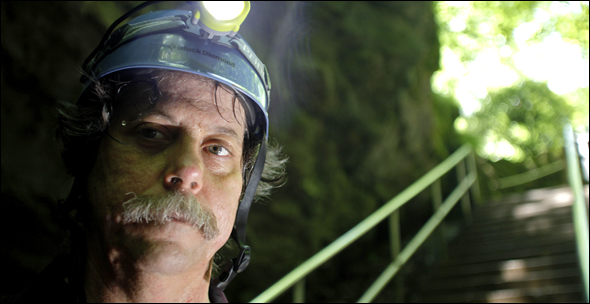
Welcome to Circle of Blue Radio’s Series 5 in 15, where we’re asking global thought leaders five questions in 15 minutes, more or less. These are experts working in journalism, science, communication design, and water. I’m J. Carl Ganter. Today’s program is underwritten by Traverse Internet Law: tech savvy lawyers, representing internet and technology companies. In early May 2010, Nashville, Tennessee, was drowning. The Grand Ole Opry and the entire downtown was under water following torrential rains. But not far away–near Bowling Green, Kentucky–researchers were going underground into caverns carved through solid limestone by eons of water flow. They wanted to get a sense of how an ancient cave system was behaving as the rains fell above. So, deep down, in Mammoth Cave, I joined Dr. Chris Groves, a world renowned cave and limestone karst expert who directs the Hoffman Institute at Western Kentucky University. I follow him on a tour of tunnels, water, and a bit of history.
Just as we’re coming down here in River Hall at Mammoth Cave is the lowest level that are on the public tours, and you can see how the floor’s kind of dark. There’s actually kind of a bathtub ring right here, so this is the highest that the water’s got just in the last couple days and now apparently is receding. This level here that you can see, this is about 45 feet higher than the normal “low” water condition. You see some of the water’s still pooled up. In fact, those benches are usually lined up along the side. They’ve apparently been floating in a lake, and that’s their position as the lake receded. You can see also these–what look like giant rulers, that are essentially giant rulers–those are kind of an old fashioned version of the methods that they used to look at the water levels during the floods. Now, actually, there’s computers that are measuring with probes back there, but just from looking at those, they saw that it was up to 45 feet.
The last time it got up here was up to right about here. . . was in 1984, so we’re real close to it. I have some data from a study in a river in another part of the cave, where it flooded in 1997, where it rained a little bit less than this one, and we have data from there that the river rose about 94 feet in 12 hours–including rising about 24 feet per hour at one point. And 1997 was here. That tape up there was from 1984. Then on the point of that rock up, there there’s actually some tags up there from 1937. So it’s definitely a very dynamic system in here.
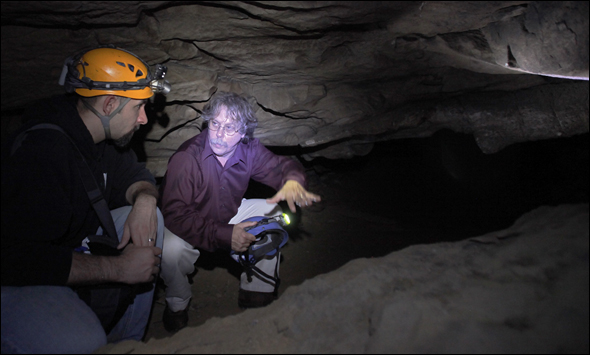
We’ll take a little side trip up here that’s pretty cool. So what happens here is that this is the place where the sandstone over top has been removed by erosion–so this waterproof cover has been removed so that you can hear all the water coming down through waterfalls, especially with the rainfall. Now if you look here, this is a bottomless pit–obviously not quite bottomless, since that’s about 90 feet–in fact, it doesn’t look as deep as it usually is because the water’s so high; it’s actually flooded back. I’m not sure, that water may be 20 feet deep? You can make the trip now; you can dive in there just like in Acapulco? I’ll hold your camera if you want, Carl–if you want to try it.
Any of these side passages we’re seeing pretty frequently. . . some of these just extend for miles and miles and miles. One thing about this is that the Cave here is not a pretty dangerous or difficult cave to explore.–I mean, it is because it’s so vast; there’s definitely very remote sections of it–but of all the hazards, this idea of flooding is really the most potentially hazardous issue.
One of the most famous cave explorers was a guy named Stephen Bishop in the 1830’s and 1840’s. He really got very interested in the Cave and made really very significant discoveries. Everything that we’ve just seen from the lower levels that we’ve just been in–Green River Hall and Mammoth Dome–he discovered. One of the stories is that right across here, what we’re seeing is a bottomless pit, he had come to this point from the main entrance up to here in the 1830’s sometime and had gone across the pit to the unexplored passage to our right and apparently had come with either a cedar pole or some kind of ladder, depending on which story you hear, and set it right across here where we are and made the first trip. During the subsequent trip, he discovered Mammoth Dome, where we came down the steps, and River Hall, the actual river that we didn’t get to see because it’s flooded. In fact, there, when he discovered the underground rivers down there, he was the first person to see the eyeless fish that are quite well known for Mammoth Cave. This was a place of great adventure, apparently.
This waterfall runs continuously, but a lot of times–during drier conditions–it’s just a little drip, drip, drip. Here it’s flowing pretty well because of the rainfall we’ve had.
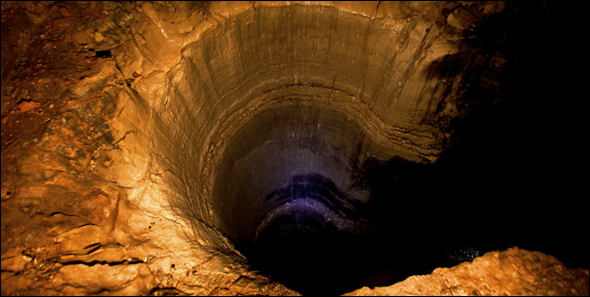
Our theme is composed by Nadav Kahn, and Circle of Blue Radio is underwritten by Traverse Legal, PLC, internet attorneys specializing in trademark, copyright, and patent infringement litigation.
Circle of Blue provides relevant, reliable, and actionable on-the-ground information about the world’s resource crises.

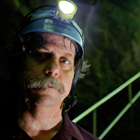
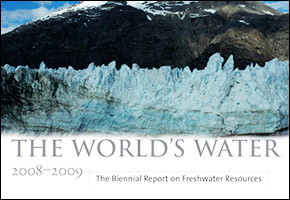
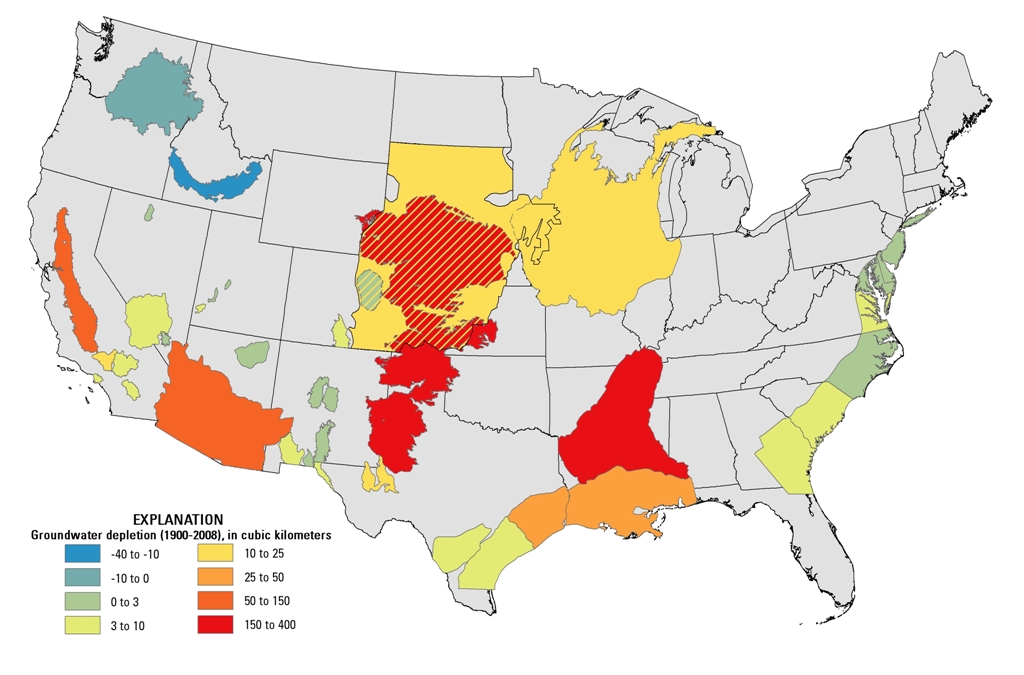
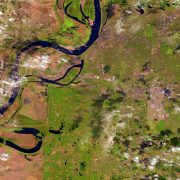
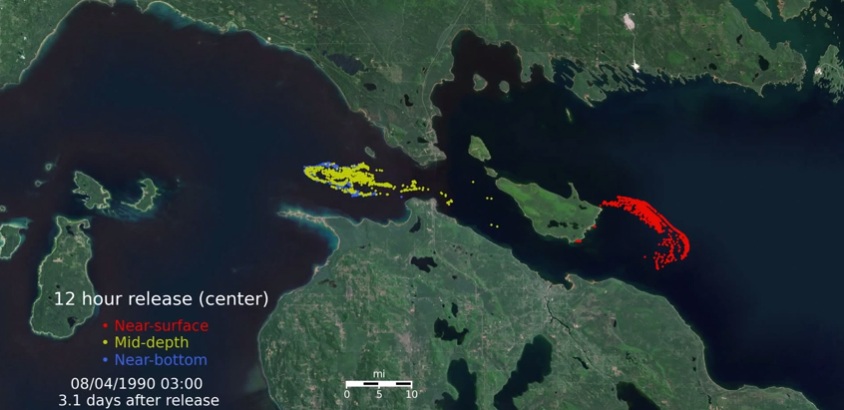
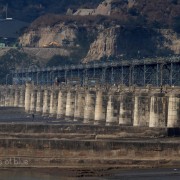



Leave a Reply
Want to join the discussion?Feel free to contribute!